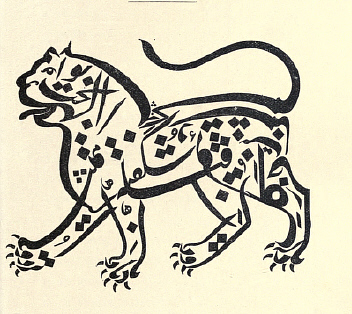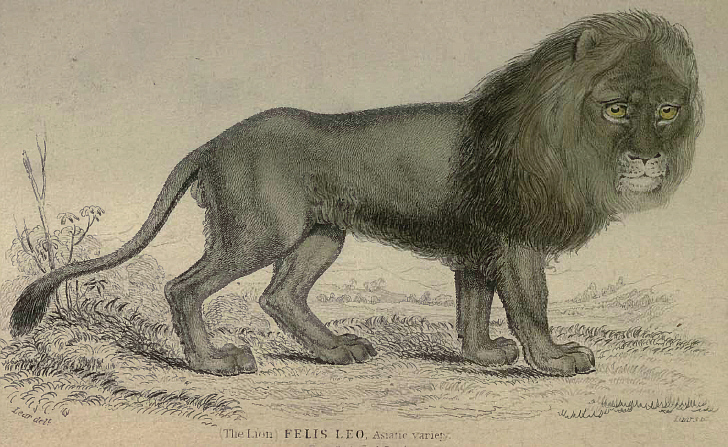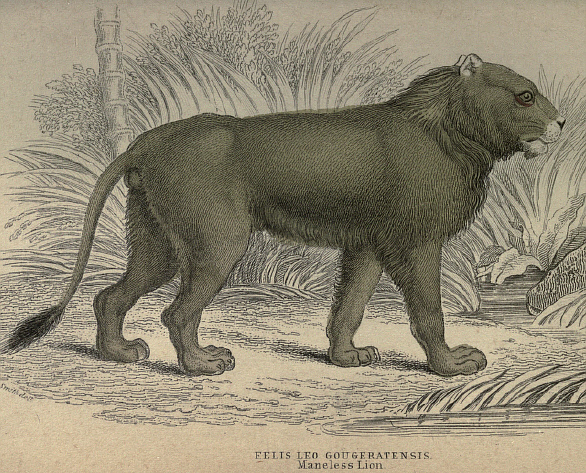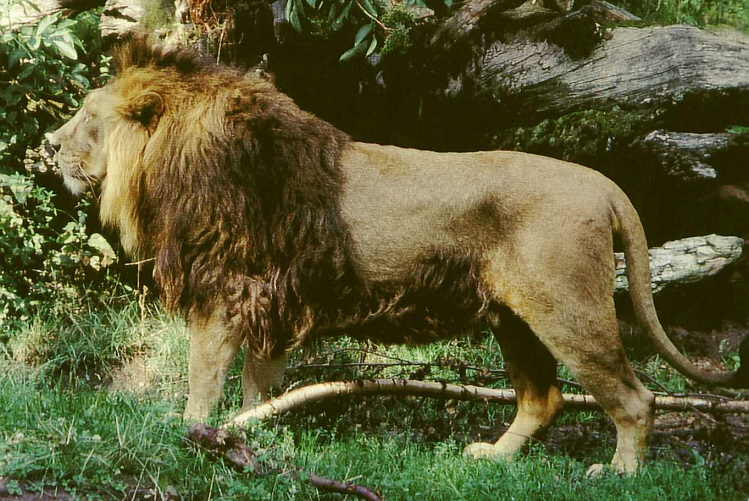

Zitierweise / cite as:
Carakasaṃhitā: Ausgewählte Texte aus der Carakasaṃhitā / übersetzt und erläutert von Alois Payer <1944 - >. -- Anhang B: Tierbeschreibungen. -- Panthera leo persica. -- Fassung vom 2010-12-09. -- URL: http://www.payer.de/ayurveda/tiere/panthera_leo_persica.htm
Erstmals publiziert:
Überarbeitungen:
Anlass: Lehrveranstaltung SS 2007
©opyright: Dieser Text steht der Allgemeinheit zur Verfügung. Eine Verwertung in Publikationen, die über übliche Zitate hinausgeht, bedarf der ausdrücklichen Genehmigung des Verfassers
Dieser Text ist Teil der Abteilung Sanskrit von Tüpfli's Global Village Library
WARNUNG: dies ist der Versuch einer
Übersetzung und Interpretation eines altindischen Textes. Es ist keine
medizinische Anleitung. Vor dem Gebrauch aller hier genannten Heilmittel wird
darum ausdrücklich gewarnt. Nur ein erfahrener, gut ausgebildeter ayurvedischer
Arzt kann Verschreibungen und Behandlungen machen!
Falls Sie die diakritischen Zeichen nicht dargestellt bekommen, installieren Sie eine Schrift mit Diakritika wie z.B. Tahoma.
Verwendete und zitierte Werke siehe: http://www.payer.de/ayurveda/caraka000b.htm

Abb.: Asiatischer Löwe = Panthera leo persica, indisch-persische
Kalligraphie von Munshi Sher Muhammad
[Bildquelle: Kipling, J. L.
<1837-1911>: Beast and man in India, 1904,
Widmung]

Abb.: Asiatischer Löwe = Panthera leo persica
[Bildquelle: The naturalist's library. -- Vol.
16. -- 1834ff.]

Abb.: Asiatischer Löwe = Panthera leo persica
[Bildquelle: The naturalist's library. -- Vol.
15. -- 1834ff.]

Abb.: Asiatischer Löwe = Panthera leo persica
[Bildquelle: Jochen Ackermann / Wikipedia. -- GNU FDLicense]
"Felis leo. The Lion.
Felis leo, L. Syst. Nat. i, p. 60 (1766) ; Blyth, Cat. p. 53 ; id. P. Z. S. 1863, p. 182; Jerdon, Mam. p. 91; D. G. Elliot, Mon. Felidce, pl. i.
Sher, Babar-sher, Singh, Hindi; Untia-bāgh (Camel-tiger), Guzerati; Sāwach, Kattywar ; Shingal, Bengali ; Sūh or Suh (male, Siming (fem.) , Kashmiri; Rastar, Brahui.
Pupil round. A heavy mane of long hair (varying in length however) all round the neck and on the sides and crown of the head in adult males only. Tail about half the length of the head and body, well tufted at the end, a small horny point at the tip, surrounded by the tuft. Caudal vertebrae 24 or 25.
The skull of a lion is thick, heavy, and massive, with a broad zygomatic arch and well-marked sagittal and occipital crests. The superior surface is remarkable for its flatness ; the postorbital processes, too, are very nearly in the same plane as the forehead. The posterior termination of the maxillary bones on the face between the orbits is opposite the end of the nasals. The exposed portion of the presphenoid bone in the inesopterygoid fossa is very narrow, and usually flat. The lower edge of the mandible is convex, owing to a small projection below the hindmost lowest molar. In all these characters the skull of a tiger differs.
Colour. Tawny (pale yellowish brown) everywhere, except the black tail-tuft and the outside of the ears, which are black towards the base, but not at the tip ; the hairs of the mane in the prime of life are also more or less black-tipped. Young cubs are marked with darker spots or irregular bands, and faint spots may often be seen on the belly and sides of almost adult or even adult animals, especially females.
Dimensions. Head and body 5g to 6½ feet long, tail 2½ to 3. A male measured: head and body 5 feet 11 inches, tail 2 feet 11 inches ; a female 5 feet 5 inches and 2 feet 7 inches. A lion measuring 8 feet 9½ inches was 3 feet 6 inches high. The female is considerably smaller than the male, and, as with tigers, some individuals probably are larger, others smaller than the above extremes. The hairs of the mane are 10 inches to a foot long in some Indian lions. A skull -of an adult male lion measures in extreme length 13 inches, breadth across xygimatic arches 9.4.
Distribution. In India the lion is verging on extinction. There are probably a very few still living in the wild tract known as the Gir in Kattywar, and a few more in the wildest parts of Rājputana, especially Southern Jodhpur, in Oodeypur, and around Mount Abu. About 20 years ago lions were common near Mount Abu, several were shot near Gwalior, Goona, and Kota, and a few still existed near Lalitpur, between Saugor and Jhansi. One is said to have been killed near Goona in 1873. In 1864 one was killed near Sheorajpur, 25 miles west of Allahabad ; and when the railway was being made from Allahabad to Jubbulpoor, in 1866, a fine lion, with a good mane, was shot by two of the engineers near the 80th milestone from Allahabad. About 1830 lions were common near Ahmedabad. Several years previously, in the early part of the century, lions were found in Hurriana to the northward, and in Khandesh to the south, in many places in Rajputana (one was shot in 1810 within 40 miles of Kot Deji, in Sind), and eastward as far as Eewah and Palamow. It is probable that this animal was formerly generally distributed in North-western and Central India. I have never heard of lions in Cutch, and suspect Jerdon was mistaken in supposing them to be found there. Eastward and north of India the lion is not found, and almost the only part of Western Asia in which it is common is in Mesopotamia and part of South-western Persia. As is well known, this animal abounds throughout Africa.
Varieties. For a long time it was supposed that the Indian lion was maneless, and in numerous books on natural history there are accounts of the "Maneless lion of Guzerat" (F. Leo guzrattensis, Smee, Trans. Z. S. i, p. 165, pi. xxiv ; P. Z. S. 1833, p. 140). It is probable that maneless male individuals may occasionally occur, and it is well known that lions in some parts of Africa, e.g. the Cape and Algeria, have longer manes than in other tracts. It is also asserted that lions inhabiting forests have shorter manes, owing to the hairs being pulled out by thorny bushes, but this is doubtful. It is certain, however, that some adult Indian lions have well-developed manes, and the typical maneless Guzerat lion in the British Museum is immature. The lion figured by Captain Smee was shot near Ahmedabad, and was a short-maned lion, similar to most Persian or Abyssinian animals.
Habits. The habits of tigers and lions are for the most part similar, except that the tiger inhabits more wooded countries. Both animals are mainly nocturnal in their movements, sleeping in the daytime and wandering greatly in search of food at night. Both are excessively powerful, and able to kill large animals, such as full-grown cattle, horses, or even camels for food, and both occasionally kill men, and are greatly feared by the inhabitants of the country. Round animals of so ferocious a nature a series of myths have naturally collected, and it is difficult to unravel the true from the false in such traditions. It is not surprising that even intelligent sportsmen, finding that particular classes of natives have a singularly accurate knowledge of the haunts and habits of wild animals, should not always be able clearly to distinguish which of these habits have actually been observed, and which are merely traditional, both being equally believed in by the narrators.
Lions are perhaps bolder than tigers, and certainly much more noisy, their habit of roaring, especially in the evening and at night, having necessarily attracted the attention of all who have been in countries infested by them. Of the two the tiger, though standing lower, is heavier in the body, and I think the more powerful animal.
In India lions feed chiefly on deer, antelopes, wild pigs, cattle, horses, donkeys, and camels, and used formerly to kill many of the latter. Whether lions usually kill their prey, as tigers do, by breaking the neck, I cannot say ; in the only cow I ever saw that had been killed by a lion, (in Northern Abyssinia) the vertebrae were not dislocated. I also saw a lioness hold a camel by the throat for some minutes, without attempting to break its neck.
Lions are more easily tamed than most of the felines. They often breed in confinement.
The period of gestation is about 108 days, and from three to six young (in India it is said two to three) are commonly born in one litter. The eyes are open at birth. Young lions want the mane, which becomes gradually developed after the full growth is attained."
[Quelle: Blanford, W. T. <1832 – 1905>: Mammalia. -- 1888 - 1891. -- (Fauna of British India including Ceylon and Burma). -- S. 56 - 58. -- Online: http://www.archive.org/details/mammalia00blaniala. -- Zugriff am 2007-09-06]